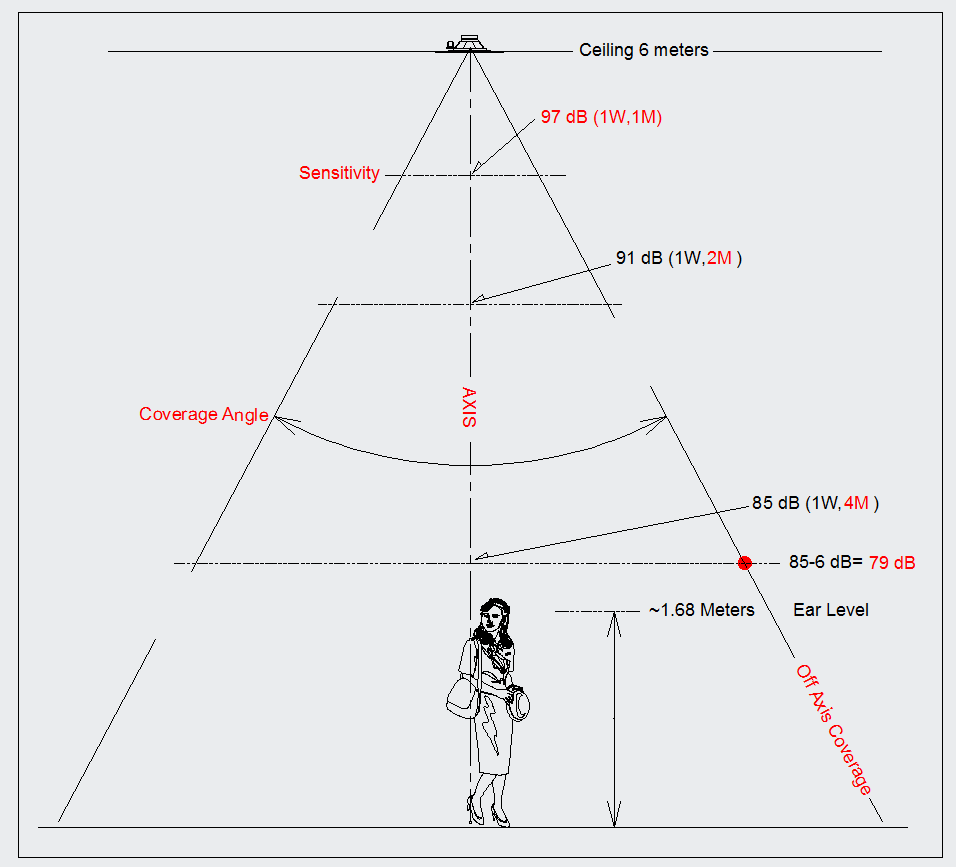Sound Talks
How much amp power do I really need?
To determine how much amplifier power is needed for a single speaker you need to know a few things.
1. What is the SENSITIVITY of the speaker measured at 1 Watt and 1 meter from the speaker on the central axis (directly under or in front of the speaker)?
An example of speaker sensitivity would be: 90 dB (1W,1M). This would be found in the speaker specification literature. In this case more is better. Using this example, the speaker will produce a sound pressure level of 90 dB with one watt of power at a distance from the speaker of 1 meter. A typical 2.7 meter office ceiling (9ft), this 1W, 1M reference point is at 1.7 meters from the floor (5.6 ft). For an average person standing, this would be almost at ear level. 90 dB is a fairly loud sound and when referenced on a sound pressure chart, would be equal to standing 10 meters from a busy highway. This level can cause hearing damage after prolonged exposure. For comparison, a normal conversation is around 60 dB
2. What happens if the power to the speaker is increased?
Doubling of power to the speaker will increase the sound pressure level (SPL) by a value of three. As an example, our 90 dB (1W,1M) speaker would produce 93 dB if the power was increased from 1 watt to 2 watts or doubled. Four watts would have the speaker at 96 dB, 8 watts at 99 dB and so one. This makes further calculations easy when working from just the sensitivity rating. These calculations are for sound pressure levels measured on axis and one must also know how the speaker levels perform when off axis.
3. Off axis response range is measured from the centre axis of the speaker to an angle that produces a 6 dB drop in SPL. This is indicated in degrees and is often called coverage angle or dispersion.
This -6 dB change is frequency dependent so for speech related investigations the 1000 and 2000 Hz frequencies should be considered as these are important to intelligibility. Checking the polar charts of the speaker will allow the installer to determine what coverage one can expect from the speaker at a given frequency. Spacing of the speakers will depend on this -6dB point and determine the evenness of the SPL over the audience plane.
4. What happens when we get further from the speaker.
Looking at the on axis response, every doubling of the distance from the speaker will cause the SPL to decrease 6 dB. For our example, the 90 dB sensitivity speaker will produce 90 dB at one meter, 84 dB at 2 meters, 78 dB at 4 meters and so on.
Keep these points in mind when selecting speakers, the Sensitivity, how much power the speaker can handle and coverage characteristics. Work with the 1W,1M sensitivity specification, then figure out the affect the distance required has on the SPL, look at the final figure then apply power as required for the application.
An example:
- A single ceiling speaker has a 97 dB sensitivity (1W,1M).
- The ceiling is 6 meters high (~20 feet).
- A typical standing persons ear (1.68M tall or 5.5 feet) is ~3.32 meters from the reference point (1W/1M).
- Calculation: Applying one watt of power = 97dB at 1 meter, at 2 meters 97-6dB=91dB, at 4 meters 91dB-6dB=85 dB
- As can be seen, a speaker with this sensitivity only needs one watt of power to produce ~85 dB at ear level.
- If more power is required because of ambient noise, increasing the power to two watts would now produce ~88 dB and so one.
In conclusion, by knowing speaker sensitivity, effects of distance and coverage angles, the correct power can be applied without amplifier power waste. These calculation only consider direct SPL and the room acoustics are not taken into account as that would be another future discussion.

- Support
- Sound Talks
-
How much amp power do I really need?